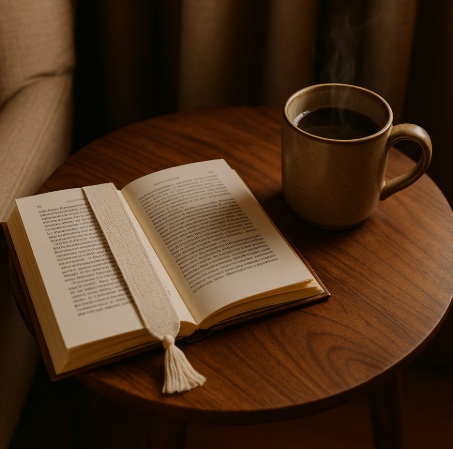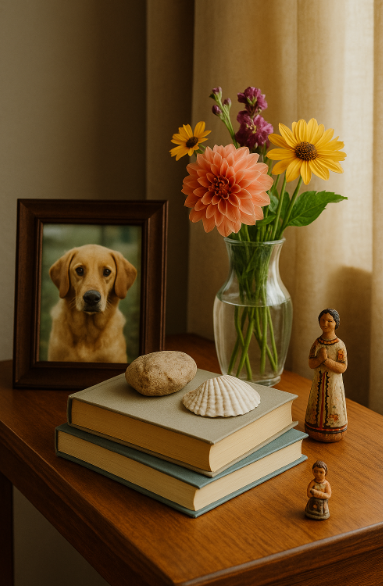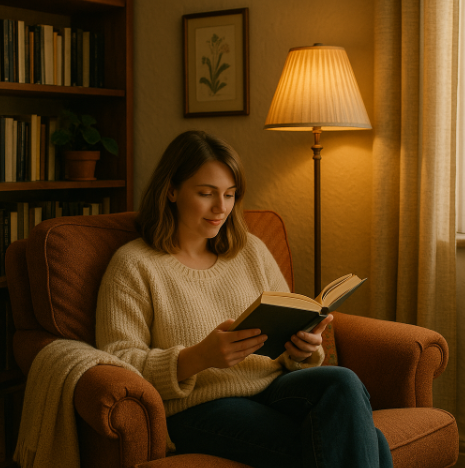Table of Contents
- Introduction
- Literary Inspiration
- The Essentials of a Cosy Reading Nook
- Bringing in Art and Textiles
- The Importance of Light
- Adding Your Personal Touch
- Conclusion
Introduction
There is something timeless about curling up with a good book in a corner designed solely for the purpose of reading. A well-crafted reading nook is not just a place to sit; it is an atmosphere, an invitation to slow down, and a space where literature and art meet. In this article, we explore how to design the perfect cosy nook, inspired by the lives and tastes of famous literary figures.
Literary Inspiration
From Virginia Woolf’s insistence on “a room of one’s own” to C.S. Lewis’s fondness for fireside reading, many authors have understood the need for a private, comfortable space. Think of Jane Austen’s quiet writing table by the window, where she penned her novels while listening to the soft bustle of her household, or Oscar Wilde’s delight in rich fabrics, ornate wallpapers, and decorative flair, which reflected his philosophy that beauty itself was essential to life. Charles Dickens often surrounded himself with objects he found inspiring, from curious trinkets to shelves brimming with books, while the Brontë sisters retreated to the wild Yorkshire landscape that seeped into their pages. Even J.R.R. Tolkien found creativity in the clutter of his study, where maps, drawings, and notes spilled across every surface.
These spaces were not simply practical; they were expressions of the writers themselves. Each corner, desk, or fireside chair became a mirror of their imagination, offering a sanctuary where the outside world fell away and the inner world of stories could flourish. To design your own reading nook is to continue in that tradition — to create a small but meaningful space that reflects not just your love of books, but also the character of the reader who inhabits it.
The Essentials of a Cosy Reading Nook
 At its heart, a reading nook requires three things: comfort, accessibility, and atmosphere. A supportive chair or cushioned bench is essential, preferably with enough space to curl up or shift position during long hours immersed in a novel. Some readers prefer the gentle sway of a rocking chair, while others favour a deep armchair that seems to embrace you as you sit. Adding a footstool or ottoman can enhance comfort further, allowing you to settle in for chapter after chapter without restlessness.
At its heart, a reading nook requires three things: comfort, accessibility, and atmosphere. A supportive chair or cushioned bench is essential, preferably with enough space to curl up or shift position during long hours immersed in a novel. Some readers prefer the gentle sway of a rocking chair, while others favour a deep armchair that seems to embrace you as you sit. Adding a footstool or ottoman can enhance comfort further, allowing you to settle in for chapter after chapter without restlessness.
Practicality is equally important. Shelving or a small side table keeps your current reads within easy reach, while a basket for extra blankets or a small tray for tea or coffee ensures you never need to leave your sanctuary unnecessarily. For those who enjoy annotating or journaling alongside their reading, a slim writing desk or lap table can also be a welcome addition.
Atmosphere, though, is what transforms a functional corner into a true retreat. This is where the magic begins: soft textures under hand, the gentle fragrance of a candle or fresh flowers, the muffled quiet of a rug beneath your feet. Layering in these details allows you to claim the nook as uniquely yours. Whether minimalist and calm, or vibrant and eclectic, the best reading nooks tell a story of their own—one that complements the stories you read within them.
Bringing in Art and Textiles
A nook becomes truly inviting when it engages more than the sense of touch. Surrounding yourself with objects of beauty transforms a simple corner into a living story. Hanging artwork that resonates with your favourite books can turn the space into a visual narrative: delicate botanical prints may conjure the landscapes of Romantic poetry, while bold abstracts might echo the restless experimentation of modernist writers. Literary posters, vintage illustrations, or even framed pages from a beloved, battered edition can add character and charm.
Textiles play an equally vital role in softening and defining the atmosphere. A patterned rug underfoot creates a sense of grounding, embroidered cushions add comfort and colour, and a tapestry draped across the wall can instantly warm an otherwise stark space. Layering textures—linen against velvet, wool beside silk—creates a tactile richness that invites you to linger.
Consider also the small details: a handmade quilt that carries family history, a shawl that once belonged to a grandparent, or a throw purchased on your travels. These are not just fabrics, but memories woven into your nook. In this way, the space becomes deeply personal as well as beautiful.
Oscar Wilde once urged that we should “live with beautiful things,” and a reading nook is the perfect canvas for that philosophy. By surrounding yourself with art and textiles that speak to your heart, you create a sanctuary where stories and surroundings are in quiet conversation with one another.
The Importance of Light
Good lighting is vital, but it should never feel clinical. A reading nook is not merely a place to see words on a page, but a space to sink into atmosphere. Natural light is ideal, so positioning your nook near a window allows you to read in the gentle company of daylight. Sunlight filtering through curtains or blinds creates shifting patterns across the floor, lending the nook a rhythm that mirrors the passage of time. A window seat, in particular, can become the heart of a home, offering both light and a view—whether of a bustling street, a tranquil garden, or the changing skies.
For evenings, however, the magic lies in lamplight. Choose a lamp with a soft, warm bulb rather than harsh overhead glare, so the glow embraces rather than overwhelms. A shaded table lamp or a brass floor lamp will cast a circle of comfort, much like the hearth fire around which families once gathered to read aloud. Think of Charles Dickens, who was said to read and write by candlelight late into the night, the flame flickering in quiet companionship. That same warmth can be recreated with carefully chosen lighting—bulbs in amber tones, or even candles for occasional evenings when you want a touch of ritual in your reading.
The quality of light sets the tone for your experience: cool, clinical light jars the senses, while warm, diffuse glows soothe the eyes and steady the mind. Lighting can be layered too—an overhead light dimmed low, a task lamp for clarity, and the gentle background of fairy lights or lanterns strung nearby. Together, they transform your nook into a sanctuary, a space where time slows, and every page feels like an invitation to linger.
Adding Your Personal Touch
 The best reading nooks are deeply personal, reflecting not only your love of books but also the texture of your life. They are places where memory and imagination meet. A framed photograph of a beloved pet might watch over you as you read, while a vase of fresh flowers brings colour, fragrance, and the subtle reminder of the season outside your window. A collection of keepsakes from your travels—a seashell from a windswept beach, a stone from a mountain walk, or a small figurine found in a market abroad—can infuse the space with stories of their own, blending with the tales you hold in your hands.
The best reading nooks are deeply personal, reflecting not only your love of books but also the texture of your life. They are places where memory and imagination meet. A framed photograph of a beloved pet might watch over you as you read, while a vase of fresh flowers brings colour, fragrance, and the subtle reminder of the season outside your window. A collection of keepsakes from your travels—a seashell from a windswept beach, a stone from a mountain walk, or a small figurine found in a market abroad—can infuse the space with stories of their own, blending with the tales you hold in your hands.
Scent is a powerful, often overlooked element. Lavender sachets tucked into a cushion, the honeyed glow of beeswax candles, or even the faint spice of incense can anchor your nook in atmosphere, making it more than a corner but a retreat for the senses. For some, the crackle of a woodwick candle or the rustle of a nearby plant adds to the quiet soundtrack of reading. Others may prefer the gentle background hum of a record player or the soft snuffle of a dog curled by their feet.
Importantly, a nook does not need grandeur to be meaningful. Even a single chair in a quiet corner, softened with a blanket and illuminated by a lamp, can become a haven if arranged with care and imagination. What matters most is that it feels like yours. In that intimacy, every page turns more easily, every story deepens, and the nook itself becomes part of the ritual of reading.
A reading nook is more than just a corner—it is an expression of one’s relationship with books. Whether your taste leans towards the minimalist elegance of Austen’s writing table or the opulent flair of Wilde’s salon, the key is to create a space that feels like an extension of your reading life. A good book deserves a beautiful setting, and in curating your nook, you are not only designing a place to read, but also an environment where art, literature, and life converge.
✍️ Submit a Guest Post
Not a member yet? You can still share your creative voice with our readers. We welcome guest posts from artists, writers, and creative souls of all kinds.
Submit Your ArticleShare this link with your friends if you enjoyed the post 🙂 See the share buttons below to your right
